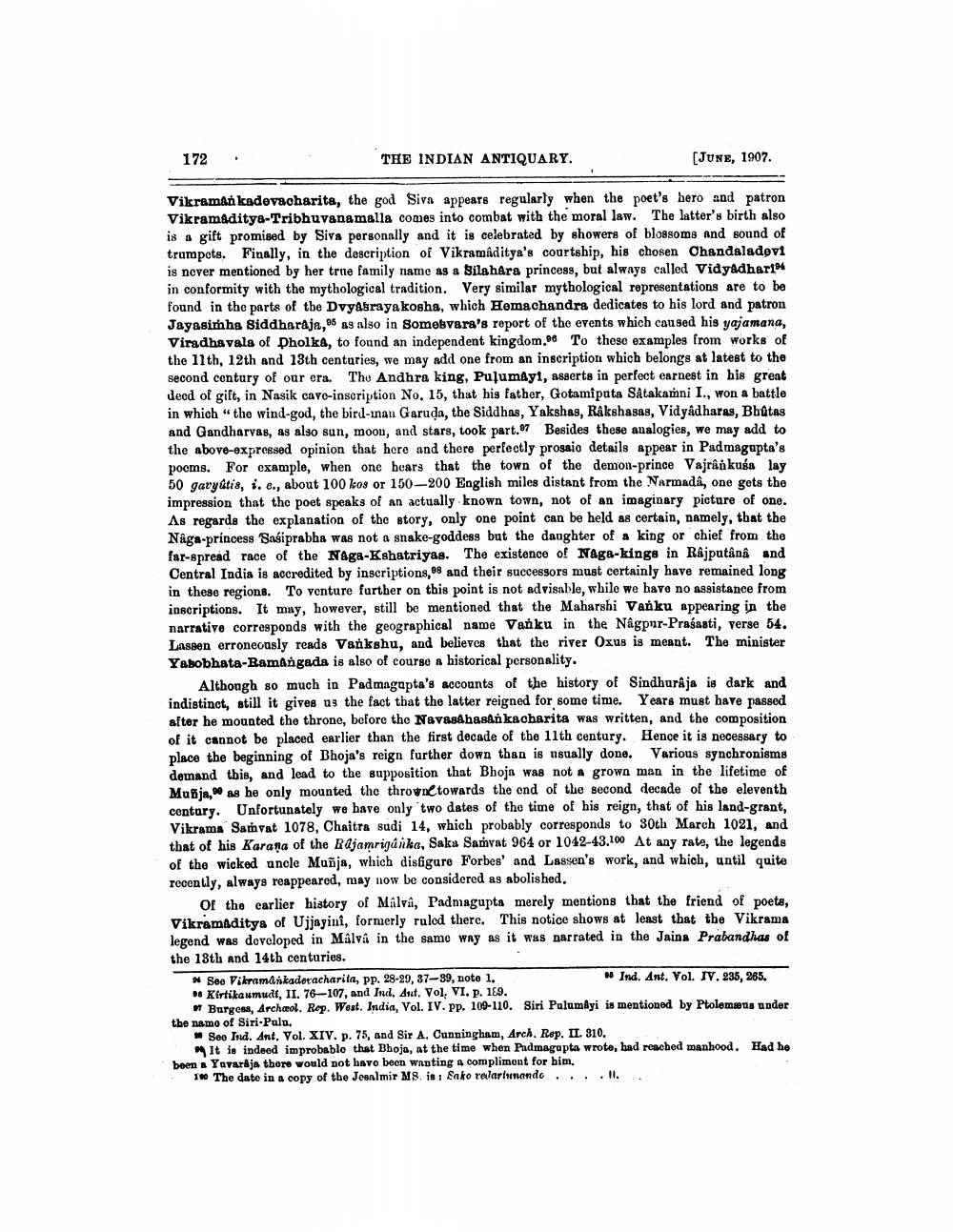________________
172
.
THE INDIAN ANTIQUARY.
[JUNE, 1907.
Vikraman kadevacharita, the god Siva appears regularly when the poet's hero and patron Vikramaditya-Tribhuvanamalla comes into combat with the moral law. The latter's birth also is a gift promised by Siva personally and it is celebrated by showers of blossoms and sound of trumpets. Finally, in the description of Vikramaditya's courtship, his chosen Chandaladevi is never mentioned by her true family name as a Silahara princess, but always called Vidyadhart in conformity with the mythological tradition. Very similar mythological representations are to be found in the parts of the Dvyasraya kosha, which Hemachandra dedicates to his lord and patron Jayasimha Siddharaja, as also in Somebyara's report of the events which caused his yajamana, Viradhavala of Dholka, to found an independent kingdom. To these examples from works of the 11th, 12th and 13th centuries, we may add one from an inscription which belongs at latest to the second contury of our ora. Thu Andhra king, Puļumayt, asserts in perfect earnest in his great deod of gift, in Nasik cave-inscription No. 15, that his father, Gotamipata Satakamni I., won a battle in which the wind-god, the bird-inan Garuda, the Siddhas, Yakshas, Rakshasas, Vidyadharas, Bhutas and Gandharvas, as also sun, moon, and stars, took part.87 Besides these analogies, we may add to the above-expressed opinion that here and there perfectly prosaic details appear in Padmagupta's pooms. For example, when one bears that the town of the demon-prince Vajrân kuga lay 50 gavydtis, i.e., about 100 kos or 150-200 English miles distant from the Narmada, one gets the impression that the poet speaks of an actually known town, not of an imaginary picture of one. As regards the explanation of the story, only one point can be held as certain, namely, that the Någa-princess Saśiprabha was not a snake-goddess but the daughter of a king or chief from the far-spread race of the Naga-Kshatriyas. The existence of Naga-kings in Rajputâng and Central India is accredited by inscriptions, and their successors must certainly have remained long in these regions. To venture further on this point is not advisable, while we have no assistance from inscriptions. It may, however, still be mentioned that the Maharshi Vanku appearing in the narrative corresponds with the geographical name Vanku in the Nagpur-Prasasti, verse 54. Lassen erroneously reads Vankshu, and believes that the river Oxus is meant. The minister Yabobhata-Ramangada is also of course a historical personality.
Although so much in Padmagapta's accounts of the history of Sindhurája is dark and indistinct, still it gives us the fact that the latter reigned for some time. Years must have passed after he mounted the throne, before the Navas&hasankacharita was written, and the composition of it cannot be placed earlier than the first decade of the 11th century. Hence it is necessary to place the beginning of Bhoja's reign further down than is nsually done. Various synchronisms demand this, and lead to the supposition that Bhoja was not a grown man in the lifetime of Muñija, as he only mounted the throne towards the end of the second decade of the eleventh century. Unfortunately we have only two dates of the time of his reign, that of his land-grant, Vikrama Samvat 1078, Chaitra sudi 14, which probably corresponds to 30th March 1021, and that of his Karana of the Rajamrigárika, Saka Samvat 964 or 1042-43,200 At any rate, the legends of the wicked uncle Muñja, which disfigure Forbes' and Lassen's work, and which, until quite recently, always reappeared, may now be considered as abolished.
of the carlier history of Malva, Padmagupta merely mentions that the friend of poeta, Vikramaditya of Ujjayini, formerly ruled there. This notice shows at least that the Vikrama legend was developed in Málva in the same way as it was narrated in the Jains Prabandhas of the 18th and 14th centuries. See Vikramarkadetacharita, pp. 28-29, 37-39, note 1.
# Ind. Ant. Vol. IV. 235, 265. Kirtikaumudi, II. 76—107, and Ind. Ant. Vol. VI. p. 169.
Burgess, Archæol. Rep. West. India, Vol. IV. Pp. 109-110. Siri Palumbyi is mentioned by Ptolemsons under the namo of Siri-Palu.
Seo Ind. Ant. Vol. XIV. p. 75, and Sir A. Cunningham, Arch. Rep. II. 310.
It is indeed improbablo that Bhoja, at the time when Padmagupta wrote, had reached manhood. Had he been a Yavar ja tbore would not havo been wanting a compliment for him.
1. The date in a copy of the Josalmir MS.is Eako relarando..... .




